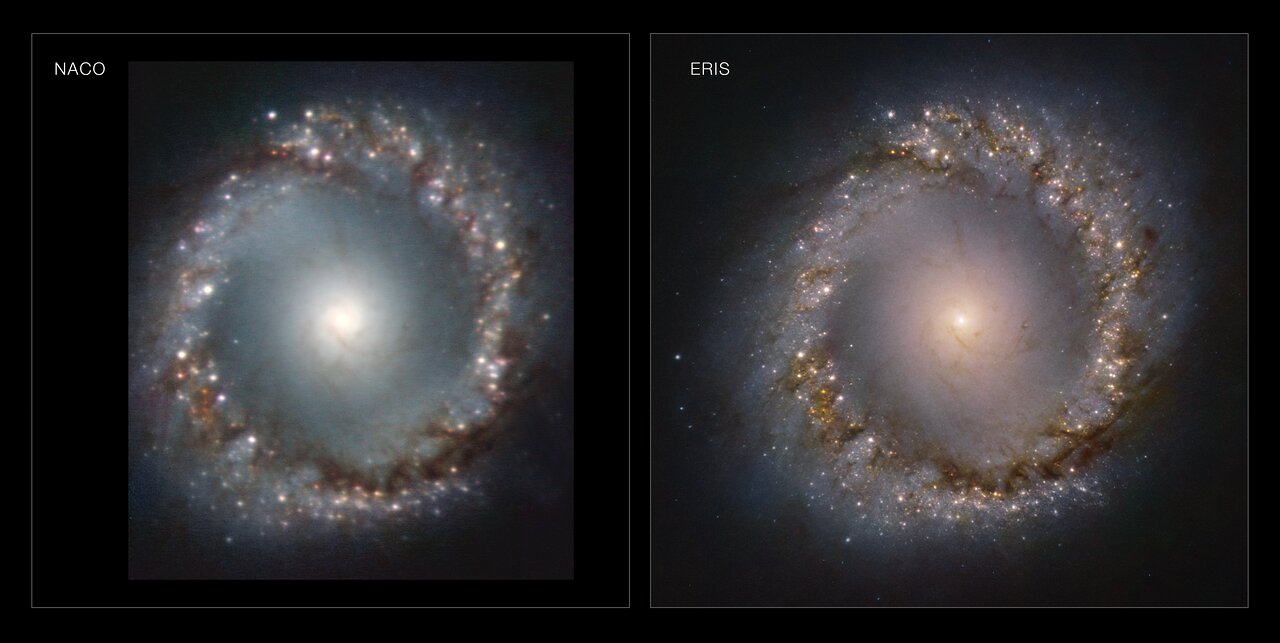Peer into the exposed heart of a galaxy in mesmerizing new image
A new image shows the exposed heart of a distant galaxy in stunning detail, demonstrating the promise of a recent addition to the Very Large Telescope.
The image shows the galaxy NGC 1097, which is located 45 million light-years from Earth in the constellation Fornax. The image was taken by the Enhanced Resolution Imager and Spectrograph (ERIS), which was recently installed on the Very Large Telescope (VLT), a telescope located at Cerro Paranal in northern Chile and operated by the European Southern Observatory (ESO). Set to operate for at least 10 years, ERIS will scan the universe in infrared, studying solar system objects, exoplanets and even distant galaxies like NGC 1097.
"We expect not only that ERIS will fulfill its main scientific objectives, but that due to its versatility it will also be used for a wide variety of other science cases, hopefully leading to new and unexpected results," Harald Kuntschner, an astronomer at ESO and project scientist for ERIS, said in an ESO statement.
Related: Starburst galaxy shines in new 'whirlpool of gold' photo
The image of NGC 1097 was captured during ERIS' second batch of observations, which occurred between August and November and followed initial test observations obtained in February.
The ERIS image of NGC 1097 is dominated by the galaxy's dusty inner ring, which is dotted by bright spots that indicate the clusters of bright and hot newly formed stars found in stellar nurseries. Seen at the heart of the sparkling ring is the active heart of the galaxy, including a supermassive black hole that is consuming matter like gas and dust from its surroundings and blasting out bright bursts of radiation.
The image demonstrates the incredible resolution of the ERIS, since it represents an area of the sky no wider than 0.03% of the full moon.
Breaking space news, the latest updates on rocket launches, skywatching events and more!
An infrared eye on the universe
ERIS is mounted on the VLT's Unit Telescope 4 and features a state-of-the-art infrared imager, the Near Infrared Camera System (NIX), which captured the NGC 1097 image. NIX uses coronagraphy, which blocks out light from stars, permitting astronomers to see fainter objects nearby, an effect similar to that created naturally during total solar eclipses.
NIX's four different filters are represented in the image by the colors blue, green, red and magenta with this last color highlighting the compact regions in the ring.
But there's more to ERIS' observations than meets the eye. NIX is also equipped with a 3D spectrograph, called SPIFFIER, which collects a spectrum of light from every pixel with the telescope's field of view, measuring how much light of what wavelength is present in that pixel. SPIFFIER will let astronomers observation of the dynamics of distant galaxies in great detail, for example, or pinpoint how fast stars are orbiting Sagittarius A*, the supermassive black hole at the heart of our own galaxy.
As ERIS studies the universe, it can use a technology called adaptive optics to sharpen its images. The adaptive optics system monitors a real astronomical object or an artificial laser "guide star"; data from these calibrations are transmitted to the VLT's deformable secondary mirror, which then adapts itself accordingly to reduce blurring. The technique helps the VLT counter the obscuring effects of Earth's atmosphere that so often blight observations made by ground-based telescopes.
"ERIS breathes new life into the fundamental adaptive optics imaging and spectroscopy capability of the VLT," Ric Davies, an astronomer at the Max Planck Institute for Extraterrestrial Physics in Germany and the principal investigator of the ERIS consortium, said in the statement. "Thanks to the efforts of all those involved in the project over the years, many science projects are now able to benefit from the exquisite resolution and sensitivity the instrument can achieve."
Follow us on Twitter @Spacedotcom or on Facebook.

Robert Lea is a science journalist in the U.K. whose articles have been published in Physics World, New Scientist, Astronomy Magazine, All About Space, Newsweek and ZME Science. He also writes about science communication for Elsevier and the European Journal of Physics. Rob holds a bachelor of science degree in physics and astronomy from the U.K.’s Open University. Follow him on Twitter @sciencef1rst.


